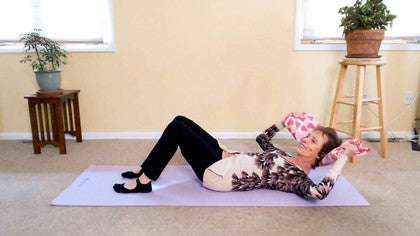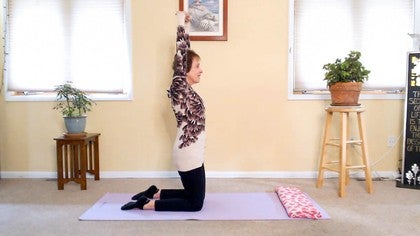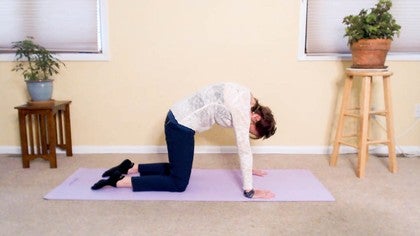Description
About This Video
Transcript
Read Full Transcript
Okay. So find a comfortable place for yourself on the floor. Once again, arranging your body, feeling yourself in the room and feeling yourself now on the floor, which is obviously different than either standing or sitting. But at the same time, you can still come into contact with various lines of energy and parts of your body that we've been talking about prior. So as you settle in, you can either have your legs extended out, which is more comfortable for some people or bending the knees and having the feet on the mat or the ground is a way to feel that contact, the base of support and the ground underneath your feet even as you're lying down.
So as you lie here, again, notice for yourself, what is the base of support? Obviously now it's the mat or the carpet, the floor, the ground that you're lying on, so take a moment feel into releasing your body weight in gravity. Take a couple of breaths, purposely arrive, relaxing your jaw again, relaxing your mouth and your facial features, and then feeling the floor under whatever parts of you is touching. So for me, it's my feet, the back of the pelvis, the palms, up the backs of my arms into the back of my shoulders. So again and again, making these relationships through our body, our feet and legs connecting through the sacrum, up the back into the shoulder blades, up into the neck, the occiput, the back of the skull and then is that oval cycles cycles down the front of the body, releasing down into the softening of the throat, the sternum, down the front of your body through the pubic bone and back down into your legs.
Taking a few easy breaths, again and again, coming back to yourself, coming back to your environment, the place that you inhabit, both outside your body and inside your body. Coming into a sense of the verticals, the limbs, the spine and the horizontals, the ankles, the knees, the hips, the lower ribs, the shoulder girdle and your eyes. Begin now to send your breath through the spine, through the central channel, inhaling again, almost like that idea of the polishing cloth. So as you breathe in and breathe out, you're opening and polishing and sending light and space into the deepest parts of your body. So you might consider a flow that comes up the length of your spine.
You could imagine your spinal column, the spinal column being continuous with your brain stem and almost like a curve like a candy cane or a walking stick, a flow that goes up the back continuous with the brain stem and then into the frontal lobe, and allow that frontal lobe of your brain to roll forward slightly, forward and down. So the eyes recede, the forehead softens, the cheekbone soften. You could play slightly nodding your head to feel that bit of rocking at the occiput, maybe feeling a bit of a tug down your back and toward your shoulder blades, maybe even feeling a bit of a tug all the way into the sacrum. And then as you continue to breathe this flow that goes up the back rolls over the back of your head, down the front, softening the face, softening the jaw, softening the throat, and allowing the breath to just be able to move in sequence smoothly through your body over and over and over again. Just taking another moment here to release any tension, feel your toes not gripping, your fingertips, have you rub your hands a little bit, bring some warmth and then place your hands back down.
And then come into the sense of your skull and the contents of your skull, your brain. And imagine your brain like a big jellyfish or a water balloon, something that has space and fluidity to it, and also a bit of weight. Perhaps you've had the experience of holding a water balloon and imagine passing it from hand to hand. And we're gonna roll our heads side to side, referring always to this flow that comes up through the ground of the feet, up the back, inhaling up the back and exhaling down and around the front. But now we're gonna add some movement for the neck and the head.
So every time you exhale, see if you can release even further, this weighted feeling of the contents of your skull, let it recede, feel the floor. I like to have a little bit of a pillow, just a bit of support for the back of my head, and then to begin to gradually roll your head, let's just say off to the right, taking your time, feeling the shift of weight. Breathing in, and breathing out and feel the shift of weight as much as you can coming from the content. So there's no pushing or pulling from the outside. You just allow the natural weight of the head, the contents of your skull and your thought, your idea, the image that your brain is rolling and shifting off to the side.
Take us a few more breaths and allow it to just shift as far over as it wants to. Notice any thoughts you might have about, oh, I'm tired, or I wish I could go further or whatever it might be, and let those thoughts be there but let them recede into the background and just have the experience that you're having. Shifting the weight, receding the eyes deeper and softer into the sockets. And when you reach your end, take a moment, take another breath, and as you begin to shift back to the middle, see if you can allow that jaw to soften even more, the tip of the chin, releasing back into those two jawlines that slide back into the ears, and soften your way back to the center, inhaling and exhaling and releasing and rolling, and letting the facial features continue to almost blur. And when you come back to the middle, start your trip off to the other side, breathing in, breathing out, continuing to roll your brain inside your head, roll, let the water, if you're thinking water balloon shift, and the container which is the skull, your head, allows for this to happen, it allows the roll to occur.
If you bump up into resistance, don't push through it, take a moment, stop, take another breath, see if you can let anything go. Maybe you wanna go a little further, maybe you don't. And then when you get to the end for you at that side, take another breath and deepen and soften into the return. So there's no pushing, there's no pulling, there's no forcing, there's just softening and deepening and rolling. You could do it over and over.
We're just gonna do it once today. Coming back to the center, settle back in, again, feeling the weight of your body, back to that sense of your brightly lit central channel. And now put your attention on the tip of your chin. Take a breath, and as you exhale, float your chin up away from your throat. Imagine it, I got a little string, it's very light, and the string is just pulling that chin up, and then stop for a moment at the top, take a breath, releasing the string, allow the chin to float, back through center and is low down toward your chest as it can without any forcing, and try that a couple of times breathing in.
And as you exhale, float the chin up, feeling the weight shift on the back of the skull, not forcing. Stay at the top, take a breath and float the chin back down. Feeling the weight shift across the back of your skull, maybe feeling something in through the shoulder blades, the sacrum, the feet. And a couple more times, chin up and chin down. Releasing the jaw, keeping the weight of the head, and then come back through the center and imagine either like a pie, apple pie, cherry pie, key lime pie, but imagine that your face is a pie.
And we're gonna for today, you could make it as small pieces as you want, but for today, we're just going to imagine that we've cut our pie in half on the vertical line and then in half again on the horizontal line, and then we're actually gonna cut our pie again, so that you have six pieces all together, three on the bottom and three on the top. And just now imagine yourself slicing through the pie. So you breathe in, and maybe the first slice is like the chin up and down. So you see the circle of the pie plate in your mind's eye, and you also just gently slice up and down easily cutting through the pie. Then come back to the center and make a slice that goes side to side.
So that's your, your brain role? So you're slicing and making very nice even pieces. So now you've got a pie that's been cut in half on the horizontal line and you cut it in half on the vertical line. So one more time, see those pieces of pie, and then let's come back to the middle and just follow along as best you can. Start in the center of your pie, take that slice up to the top, and then you wanna try to loosen it from the pie plate.
So you're gonna make a curve that goes over to the right and down and stops at your horizontal. So back and forth, back and forth. We have a quarter of the pie now, and then you can cut in to the center and back up to the top. So in your mind's eye, keep defining that quarter piece of pie that's to the upper right of the pie plate. And you can see that I'm mimicking the movement with my hand.
It helps me stay focused, it helps me keep the picture, keeps a little movement in my body. And then let's try the piece of pie, the quarter of the pie that's off to the left. Breathing in and breathing out, take that slice from the center of the pie up, and then allow yourself to see that you're loosening a little bit the crust that rolls to the left and that upper quarter. Maybe you wanna roll back and forth a few times to make sure that you really loosen that crust, and then stay off to the side left and cut back into the center. It's totally up to you.
You can keep redefining the quarters. If you get lost, you can come back down through the middle, all the way to the bottom, up, arch to the left, come through the middle, arch up to the right, back and forth and then let's explore the bottom half of the pie tin. So just for consistency, come back to the middle and take that slice down. So you would say that that's the same as your chin down motion. And then let's stay down at the bottom and create a loosening of the pie crust that takes you on the lower quarter.
Feel into that. And if the pie crust gets a little stuck between the bottom and the side, just take your time and loosen that pie crust and then you could choose to serve that piece of pie by cutting back in through the center and back down, or any direction that you like. And now we've got three very clear quarters of our pie. We've got one quarter left. So come up to the middle, slice it down and picture yourself, Shannon Knows carving and loosening the pie on the lower left bit of the pie plate.
One last time now, define that bottom left quarter, and then release and come back to the center. So I know I said we were gonna do it in six pieces, but I think four is enough. Knowing that at any time you could make as, it depends how many people you have over, right? You can make quarters, sixths, eighth, every little bit of that pie, up and down side to side, arching, seeing all those beautiful little patterns in your mind and freeing up all the little muscles deep inside your head and your neck. Take a nice deep breath, let that go.
Now, we're gonna come to the nose circles. So we've mostly had our attention on the tip of our chin as our initial guide. Now, we're gonna put the attention on the tip of the nose. So what you're picturing now is that your nose reaches out to a point in space, and it's as if there is a cone shape on your face now. So the small closed tip end of the cone is out in space and the open circle wider part, the open part of the cone is on your face.
And in your mind now choose a color, and put a nice amount, like a very rich, deep color or if you like pastel, but make sure that your magic marker or your colored pencil has enough color so that when you reach out in space in your mind to the tip of the nose, reaching out into that cone tip that you have enough color to draw circles. Now, you're going to picture yourself drawing the circles with the tip of your nose out in space. It may be that if somebody was watching you they wouldn't see a lot of movement. It's really your call. You may feel the head moving, you may just sense that extension, that reach, that lightness out in space, at the same time allowing the skull to remain heavy, the jaw soft, the throat easy.
So as you picture the circle and you picture the color, notice if there's any part of the circle that kinda cuts out and you wanna make that circle as smooth and perfectly round as you possibly can. So if you have a part that either doesn't have enough color or feels a little jagged, take your time and maybe trace back and forth until you feel confident that there's plenty of color and the entire circle is nice and full. And then when you feel good about that, reverse it. Picture that tip out in space, small circle over and over, picturing that in your mind's eye. And when you feel satisfied that you have a lovely, open, pure, smooth circle, start bring your awareness down the cone.
So more to the open-end, the larger end, the part of the cone shape that is closer to your face. Keep the nose as the focus, but begin to draw larger circles that are closer to you, and let your mind see that circle in the same way. So again, you may have a part of the circle that wants to cut the corner. Be curious about that and just maybe trace back and forth a little bit. You may even encounter some crust crumbs along your circle.
You might be able to taste the pie right about now, and when you're satisfied that you've created lovely, rich color, pure round circles, go the other way, couple of times. And take a nice deep breath and come back to the center. Maybe sway your legs a little bit. You need to stretch your legs out, do that, and then come back to your comfortable position. Relax, and I have this blanket here, and I do it like I said, because it's, my structure feels better with a little bit of support under my head.
But if I take the two ends of my blanket, you could have a towel. I can pull up on that and release the weight of my skull into the blanket. You could use a towel. And as I hold that up, I can feel the relationship between the weight of my skull and my sternum softening back down into my mid upper back. And I could gently hold the ends of that blanket and give myself a supported role, kind of like your brain role but a little different now, bringing a little bit more muscularity into this structure.
But still feeling that the weight of my head, the contents of my skull is supported, so using some arm strength, and I could take a moment as I roll to the left and lift a little bit the right side up, feel how that might release me into my upper back shoulder. Come back through the center and release letting the jaw go. That's it. Allow the weight of the head to really be held by the strength of your arms into the shoulder girdle, come back to the center and let the weight of your skull release back down. Okay.
And that's enough.
Mindful Movement: Moving Meditation
Comments
You need to be a subscriber to post a comment.
Please Log In or Create an Account to start your free trial.












